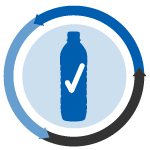 The U.S. Food and Drug Administration will allow recycled PET fiber to be used to make tea bags, fruit or meat packaging and more. It also gave the go-ahead to use recycled plastics in several types of thermoform packaging.
The U.S. Food and Drug Administration will allow recycled PET fiber to be used to make tea bags, fruit or meat packaging and more. It also gave the go-ahead to use recycled plastics in several types of thermoform packaging.
Those announcements came in various letters of no objection (LNOs) issued by the agency since the beginning of the year. In all cases, the Food and Drug Administration (FDA) determined the recycling processes would result in contaminant concentrations of 0.5 parts per billion or less in the food, below its “threshold of regulatory concern.”
One notable trend is the fact a number of the recent letters were issued to companies based outside the U.S.
In this twice-yearly roundup, Plastics Recycling Update looks at letters covering PET, HDPE and PP used in a variety of food and drink packages. For a previous roundup, which covered the second half of 2016, click here.
Slew of PET letters
A Jan. 30 LNO covers the use of post-consumer PET at up to 50 percent recycled content. The Fraunhofer Institute for Process Engineering and Packaging had submitted the request on behalf of Technip Zimmer of Frankfurt, Germany. The letter says a so-called “Super Clean” process can be used to create recycled PET for use in containers that are hot-filled, cold-filled and heated with microwaves. The feedstock would be both food and non-food post-consumer containers.
An April 26 LNO allows the use of post-consumer recycled PET in drink bottles at up to 100 percent recycled content. The letter was issued to MFX Corp., which submitted to the FDA on behalf of Brazil-based company Viscotech Industrias e Comercio de Plasticos Tecnicos. According to the letter, the recycled PET would be used for beverage containers holding mineral water, juices, sodas, alcoholic drinks and isotonic drinks bottled. The feedstock would be food and non-food containers.
An April 27 LNO to the Fraunhofer Institute for Process Engineering and Packaging covers the use of recycled PET fiber for use in a variety of food-contact applications. Fraunhofer had submitted to the FDA on behalf of Advansa of Hamm, Germany. The LNO says the post-consumer PET fiber can be used at up to 100 percent recycled content to make tea bags, milk filters, casings and nonwoven fruit or meat packaging. The foodstock would consist of both food and non-food containers.
A May 26 LNO green-lights the use of post-consumer PET in a variety of bottles and thermoforms. The letter was sent to Wiley Rein LLP, which submitted to the FDA on behalf of Custom Polymers PET of Athens, Ala. The letter states a feedstock consisting strictly of food packaging could be used at up to 100 percent recycled content in containers with low-alcoholic (equal to or less than 8 percent alcohol), aqueous, acidic and dry foods at room temperature and below. In addition, the letter says a feedstock consisting of both food and non-food containers could be used at up to 100 percent recycled content in thermoformed trays and clamshells under hot-fill and cold-fill conditions.
A June 22 LNO allows the use of post-consumer PET at up to 100 percent recycled content in a variety of thermoformed items, including clamshells, cups, bakery item packaging, deli containers, produce platters and more. The letter was issued to Keller and Heckman LLP, which submitted on behalf of rePlanet Holdings, Inc., which is based in Ontario, Calif.
A July 10 LNO covers the use of post-consumer PET at up to 100 percent recycled content in sheet for thermoforming. The letter was sent to the Fraunhofer Institute, which applied on behalf of Italy-based company Luigi Bandera.
In all of the above cases, the PET feedstocks must exclude industrial and chemical containers.
HDPE for fatty, high-alcohol foods
A June 1 LNO covers the use of recycled HDPE at up to 100 percent recycled content in packaging for fatty foods and high-alcoholic drinks. The letter was issued to Keller and Heckman LLP, which submitted on behalf of Reidsville, N.C.-headquartered Envision Plastics. The feedstock would be limited to HDPE used in food and drink packaging, such as milk, water and juice bottles.
PP packaging letter
A July 7 LNO allows the use of post-consumer PP at up to 100 percent recycled content in food containers. The letter was sent to Keller and Heckman LLP, which applied on behalf of Reidsville, N.C.-headquartered Envision Plastics. The described feedstock consists solely of PP items that held food, including yogurt cups and margarine tubs.
More stories about technology
- RIT researchers develop AI-based textile recycling system
- Industry nuance is key in adopting emerging technology
- Google, Dow partner on AI to identify recyclables


